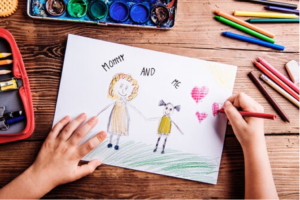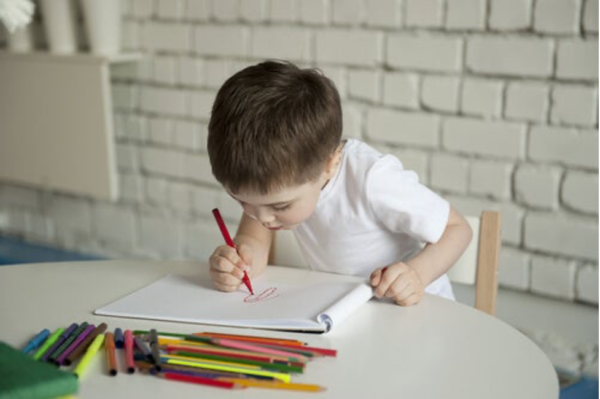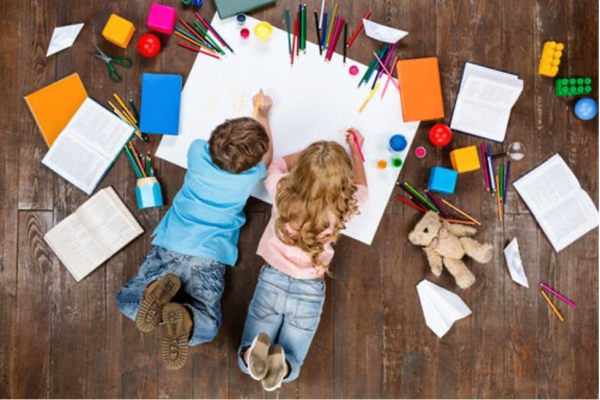Children's Drawings: A Window to Their Inner World

Drawing is a powerful tool and children’s drawings express their emotions. Painting is a liberating act. Nobody teaches you to draw because it’s simply not necessary. You just start doing it naturally.
Children are fascinated by drawing and they tend to focus all their attention on it. It’s an activity that motivates them, stimulates them, and gives them their own space.
Language isn’t yet developed in the very young and drawing is an essential communication tool for them. Therefore, drawing, apart from being a valuable activity, is a great way for them to understand their feelings and relate to them.
For this reason, it’s very important that you don’t limit or restrict children in their drawing. Don’t tell them how they should or shouldn’t do it. It’s essential that they’re given the freedom to enjoy themselves. This way, you can also learn a little more about their inner world.
“Children keep their dreams in pencil boxes.”
-Ramón Gómez de la Serna-

How does the ability to draw develop?
When a child starts to draw, you might think there’s no particular pattern or order to it, but you’d be wrong. Children’s drawings are organized based on basic laws, such as uniformity or continuity.
The child’s scribbles and shapes reflect the experiences they’ve had in their life. After organizing them in their mind, they turn them into their own personal creations on paper. This way, children synthesize what they observe. They then represent the model they have created within themselves, the model that allows them to organize their perceptions of the environment.
The analysis of children’s drawings is generally conducted from three key aspects: their structure, theme, and how they evolve throughout childhood. There are different stages of artistic development. However, whatever culture or country they might come from, children all start in the same way, by scribbling.
The stages of artistic development
Between the ages of two and four, children begin drawing by scribbling and drawing lines. Right from the start, most of them love this activity. Then over time, their strokes become more controlled and they start to identify their creations as things in the real world. Whilst their depictions may bear no resemblance to the actual objects themselves, this development actually shows real advancement in their abilities.
Around the age of three, they start to draw proper shapes. Suns, circles, triangles – basic shapes that they’ll later combine to create multiple designs. Then, from the age of four to seven, they make their first attempts at representation.
From now on, their images start to be recognizable and their subjects can be distinguished. They enjoy drawing things like people, houses, and trees. However, the human figure is always their favorite subject. Furthermore, at this stage, they make great efforts to connect their internal representation with the real world. Indeed, their drawings contain what’s meaningful to them and also reflect how they relate to their environment.
Around age seven, there are changes in the way children express themselves in their drawings. From now on, they exhibit a clear personal style. Furthermore, their use of color and shape becomes established. Their drawings start to exhibit spatial order. Figures and elements are oriented. For example, the lines of the sky or ground appear.
From now on, there’ll be an increasing number of details, symbols, and social content. Consequently, their pictures will become richer, especially if they continue to developing their artistic side. Then, in adolescence, there can be a real explosion in their creativity.
“Left to their own devices, children can successfully practice any way of working very different from the one we consider.”
-Jacqueline Jarrett Goodnow-
Children’s drawings convey their emotions
Painting usually plays a very important role in the cases of children who suffer trauma or other disorders. In these instances, drawing is a way for them to express their inner turmoil.
For a properly trained psychologist, drawing can be very useful. They can use it to generate hypotheses for a child’s diagnosis, or simply to understand the child’s personality. For example, they might organize a drawing activity in a consulting session. This way, the child doesn’t feel under any pressure to speak and can relax, even though they’re in a totally strange environment.
Drawing helps release tension and allows the child to open up. Therefore, through paper and paint, they can communicate about their world with no need to actually talk. That’s because this kind of free artistic expression promotes a playful environment. Furthermore, it provides information on the child’s state of mental development.
The process of art therapy
The drawing act itself conveys important information. The professional, using the observation technique, is able to analyze how the child expresses themselves. This is because the child’s personality will be reflected in various different aspects: their movements, their attention span, their strokes on paper, the way they arrange figures, the elements they choose, the colors they use, etc.
The relaxed environment encourages children to make their own creations. Alternatively, if the psychologist needs to study something in particular, they might suggest a specific subject to the child.
Children who are exposed to high stress or trauma reflect their distress in their drawings. In these drawings, they represent what they’ve lived through. The drawings can be very explicit, depending on the child’s age.
In these sessions, the child is the one who takes the lead in the drawing at all times. Therefore, the act of painting works like a mirror, reflecting what needs to be expressed.
“I prefer drawing to talking. Drawing is faster, and allows less room for lies.”
–Le Corbusier-

What messages do children’s drawings give us?
When a child draws, you can understand a lot about their development, like their attention capacity, for example.
Children usually enjoy painting and get extremely engrossed in it. However, if a child is unable to maintain their attention when drawing, it could be the case that their attention towards other tasks is even worse. In this instance, it’d be a good idea to discover whether it could be due to attention-deficit/hyperactivity disorder.
By looking at their creations, you can also estimate the child’s degree of complexity of thought. This also tells you whether they’re advanced for their age or not. Very intelligent children typically draw more complex drawings. On the other hand, cognitive deficiencies tend to be associated with poor or lower-level drawings, dependent on the child’s age.
At the same time, a child’s drawings open the door to their personality and emotions. Painting is a tool that lets the child communicate. They can explain the way in which they relate to their environment, and also how they tend to project their family, their home, and their friends.
Analyzing children’s drawings
Children who have suffered catastrophes or wars tend to draw scenes of conflict. By this, they’re trying to assimilate what happened, hear it in their minds, give it some sort of meaning, and accept it. At the same time, they’re distancing themselves and transferring some of their feelings onto paper. In fact, it’s as if, through the painting, they’re releasing some of the burdens they’re carrying.
On the other hand, you can also analyze other aspects. These might be the size of the figures, their distribution, positioning, colors, and the marks and symbols. These can reveal many underlying meanings.
What colors stand out? Are the strokes calm, aggressive, or nervous? Is there an inconsistency in the positioning of the figures? Are the characters unfinished? How are the spaces distributed?
You can talk to the child to get their own story behind the painting, thus learning how they interpret it themselves. At other times, the professional must explore conflicting aspects that the child may not reveal directly or that they might play out through some sort of fantasy.
A child who’s suffered sexual abuse might draw a picture of themselves in bed with their father, with the father’s hand on their body. Alternatively, a girl who has a conflict with her mother might draw the mother far away from herself, or may not even draw her at all. She might use dark colors and incomplete strokes and might not draw any facial or body features. For example, the mother may have no mouth.
Interpretation of children’s drawings
Of course, all these aspects must be studied by a professional. Their interpretations of the drawings will form hypotheses that will need to be confirmed by a thorough psychological examination. Naturally, the professional must analyze each case subjectively.
There are many variations, and it’s impossible to make a diagnosis on the basis of a simple drawing. Therefore, other types of tests and interviews need to be conducted.
However, drawings remain a very valuable tool in communicating with children. Drawings can also help in communicating with the elderly in cases where direct communication is insufficient or has been closed off.
“Every child is an artist. The problem is how to remain an artist once he grows up.”
-Pablo Picasso-
All cited sources were thoroughly reviewed by our team to ensure their quality, reliability, currency, and validity. The bibliography of this article was considered reliable and of academic or scientific accuracy.
- Quiroga Méndez, M.P. (2007). Estructura y temática en el dibujo infantil, aportaciones fundamentales. Revista Papeles de Pedagodía. UPSA Nº8. Enero-junio 2007, pp. 153-176.
- Quiroga Méndez, M.P. (2009). Psicología infantil aplicada I. Temperamento, dibujo infantil, inteligencias múltiples, sueño y emociones. Universidad Pontificia de Salamanca. Salamanca. KADMOS.
- Saínz, A. (2003). Conocer al niño a través de sus dibujos. Madrid. Ediciones Eneida.
This text is provided for informational purposes only and does not replace consultation with a professional. If in doubt, consult your specialist.








